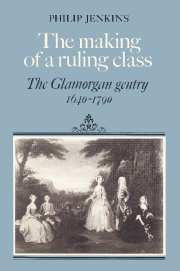Book contents
- Front matter
- Contents
- List of maps and tables
- Acknowledgments
- Abbreviations
- General introduction
- PART I SOCIAL AND ECONOMIC STRUCTURE
- PART II LOCAL AND NATIONAL POLITICS
- PART III SOCIETY AND CULTURE
- Conclusion to Part III: ‘conspicuous antiquity’
- Aftermath: towards the Victorian world
- Conclusion: from Civil War to Industrial Revolution
- Appendix 1 Parliamentary service by Glamorgan landowners 1640 – 1800
- Appendix 2 The ‘secondary’ gentry families
- Appendix 3 The ‘tertiary’ families
- Appendix 4 The Mansell family and their connections with the greater gentry
- Appendix 5 The roundhead and puritan family links of the Thomases of Wenvoe
- Notes
- Index
Conclusion: from Civil War to Industrial Revolution
Published online by Cambridge University Press: 22 September 2009
- Front matter
- Contents
- List of maps and tables
- Acknowledgments
- Abbreviations
- General introduction
- PART I SOCIAL AND ECONOMIC STRUCTURE
- PART II LOCAL AND NATIONAL POLITICS
- PART III SOCIETY AND CULTURE
- Conclusion to Part III: ‘conspicuous antiquity’
- Aftermath: towards the Victorian world
- Conclusion: from Civil War to Industrial Revolution
- Appendix 1 Parliamentary service by Glamorgan landowners 1640 – 1800
- Appendix 2 The ‘secondary’ gentry families
- Appendix 3 The ‘tertiary’ families
- Appendix 4 The Mansell family and their connections with the greater gentry
- Appendix 5 The roundhead and puritan family links of the Thomases of Wenvoe
- Notes
- Index
Summary
To return to my initial question: why did the world of Beaupre die? – or in-deed the world of Llantrithyd or Van, all now standing as magnificent ruins in fields. This ‘classical’ gentry society flourished in the first decades of the seventeenth century, and was largely supplanted by the late eighteenth century. Already by 1800 the ancient lines of Bassett, Turber-ville and Mansell had either vanished from the country or had been reduced to a very minor status. Glamorgan was now the country of iron and coal, of the great industrialists; but there was still a gentry, wealthier and more powerful than ever, with a wholly new social and geographical outlook, new relationships with social inferiors, new justifications for their existence and power – this was a widespread phenomenon in England and Wales. It is an obvious temptation to associate these changes with the one great political upheaval of the period, the Civil War and Interregnum, to argue that the old gentry were irretrievably cripplecd by 1660, and that the new gentry arose on the new post-war social foundations. Few would now see the Civil War as a straightforward bourgeois revolution, although it might well be clamied that it laid the foundations for a later bourgeois triumph, which in turn led to industrialisation.
- Type
- Chapter
- Information
- The Making of a Ruling ClassThe Glamorgan Gentry 1640–1790, pp. 276 - 286Publisher: Cambridge University PressPrint publication year: 1983

